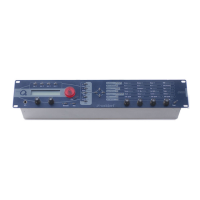Sound Parameters – Arpeggiator
Waldorf microQ User´s Manual 100
Arpeggiator
An Arpeggiator is a device that splits an incoming MIDI chord into its single notes and repeats them
rhythmically. Different sequence modes can be defined for the Arpeggiator to cover a wide range of
applications. In addition to the synthesis features, the microQ offers a deeply programmable
Arpeggiator for every sound program. It can play a wide range of different rhythm patterns including
accents and different timings, and allows creating sophisticated custom rhythm patterns.
The arpeggiator uses a so-called note list that can store up to 16 notes. This list is set up depending on
the Arpeggiator parameter settings. For example, when Sort Order is set to Num Lo>Hi, the list is
rearranged so that the lowest note is placed at the first position, the second lowest note at the next
and so on. Refer to the individual parameter descriptions to see if and how a parameter alters the list.
Arpeggiator Parameter Controls
The most commonly used controls of the Arpeggiator can be directly accessed via the Amp/FX/Arp
section.
Arp Mode Off / On / One Shot / Hold
This parameter sets the way the Arpeggiator works.
• If Off is selected, the arpeggiator is not active.
• If On is selected, the arpeggiator is active. When you press a note or a chord on the
keyboard, it is split up and repeated rhythmically. As soon as you release a note, it is
removed from the arpeggio rhythm. Conversely, as soon as you add another note to the
existing chord, it is inserted into the arpeggio. When you release all notes, the arpeggiator
stops.
• If One Shot is selected, the arpeggiator splits up all played notes and plays back an arpeggio.
The actual length of this arpeggio is set by the Pattern Length parameter. After the arpeggio
rhythm is played once, it is stopped automatically unless you hit a new chord. This mode is
especially useful in a live performance where you might have to “synchronize” yourself, for
example, to a drummer. Just hit a chord at each new bar.
• If Hold is selected, the arpeggiator splits up all played notes and generates a continuous
arpeggio even when the chord is released. This gives you two ways of entering a chord:
1. Press all keys of the chord simultaneously. This is the normal procedure you would
follow with the other Arpeggiator Modes, too.
or
2. Press and hold the first key of the chord. While holding this key, enter the other keys
sequentially. After playing all keys, you can release the first key. On one hand this
method is practical for playing difficult chords, and on the other hand it is essential
when using the as played setting of the Sort Order parameter. This setting allows you
to create arpeggios in the sequence of played notes. You can even hit the same note
several times and it will appear in the note list accordingly.
You can stop playback of the Arpeggiator by pressing the Power/Panic button, by setting
Mode to Off, On or One Shot, or by sending an All Notes Off message from your sequencer.

